| 1. Get yourself some sourdough starter. We keep ours in a handy Fowlers Vacola jar, with a silicone lid to allow gas to bubble out and, at the same time, to keep dust and wild yeasts out. Start with about one fifth of a jar of starter. (Although your jar starts nice and shiny, after a few days it will quickly look like this!) |
 |
| 2. This is the important part. Every day for a few days, feed roughly equal amounts of flour and water to the jar and stir, to increase it by about a fifth each time. The mixture should be a bit like a thick pancake batter. After a few days of feeding, the jar will be almost full, and it ‘should’ look like this – frothy and foamy. |
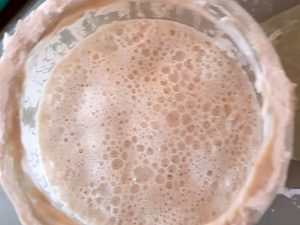 |
|
3. If you have forgotten to feed it for a couple of days, it might look more like this, with a film of water over the top, or sometimes a film of dark liquid.
A starter that looks like this is still fine, but indicates that it is ‘inactive’, so you need to feed it again until it is nice and frothy and can raise your loaf of bread properly. (It’s a bit like when you haven’t eaten properly for a few days or drunk enough water and feel a bit sluggish and can’t work at your best – you have to feed it regularly for it to stay active and healthy.) This is a common problem when a sourdough bread does not rise – the starter was not active enough and you have been too impatient to give it a couple more days!
|
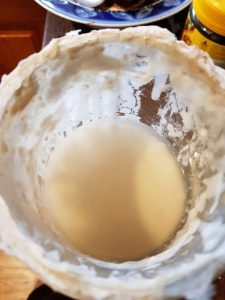 |
|
4. Pour most of the starter into an average size mixing bowl, leaving a fifth in the jar to start feeding up again. You can change to a clean jar if you like. Mix in equal amounts of flour and water to bring the bowl to about half full. Mix it and make sure that it is still the same consistency as it was in the jar – it doesn’t matter if it is lumpy and the flour is not all smoothly mixed in.
Cover with a beeswax wrap or silicone cover and leave overnight – around 12 hours. The next morning it should look nice and frothy, just like it did in the jar, and when you stir it with a spoon it should look and feel a bit gelatinous.
|
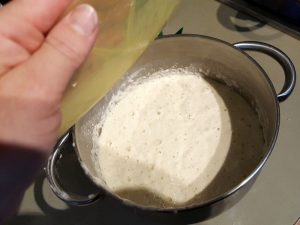 |
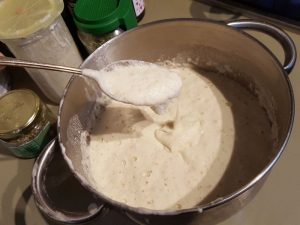 |
| 5. Add in salt to taste (I use 3 teaspoons) and mix in enough flour (wholemeal or white) to make a consistency that you can knead without it sticking to everything – but still as moist as possible. Do NOT add any more water at this stage. |
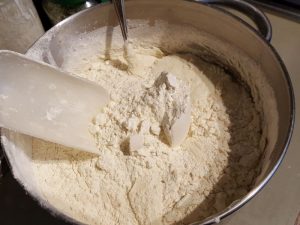 |
|
6. Either knead it in the bowl or turn it onto a floured benchtop and knead it all together for just a couple of minutes – enough to make sure everything is mixed in. Then halve and put half each into two oiled bread tins. The best tins are proper beard tins that have a film of oil baked onto the sides of them – I found mine in an op shop.
Cover with a beeswax wrap and leave either in a warm spot or, if it is winter, you can put it into a very low oven to rise. The longer that it gets to rise, the moister the bread, but you can also force a faster rise (a couple of hours in a warm oven) if you are in a hurry. 6 hours or so is a nice length of time.
|
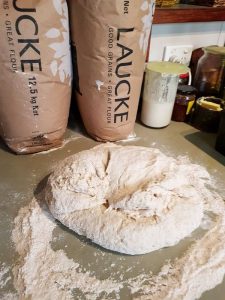 |
 |
| 7. Once it has doubled in size, put it in a pre-heated oven at 180degC and cook for 45 minutes. |
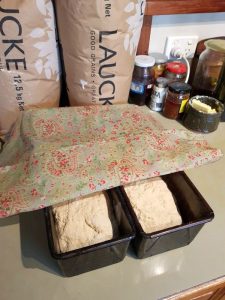 |
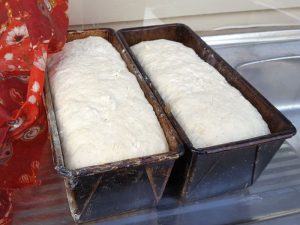 |
| 8. Enjoy! |
 |












Hi Lucinda,
Do you have a recipe for sour dough starter?
Cheers
Michelle
Hi Michelle,
The easiest thing is to just get some starter from someone else who is local to you. If you have a local permaculture group or food swap, talk to them and you might find someone who can help you.
My own experience is that everything about sourdough takes time, including time for the starter to mature, time to properly knead the ingredients, and time for the dough to rise (twice). Lucinda’s detailed words were in line with this experience but I worry that her title and introduction downplay some of the challenges. The risk is that newcomers assume that it is easy and then get discouraged when they find that it is not.
Thanks for your comment, David. While various parts of the process do take time while the starter or dough is sitting doing its thing, the amount of active time that I spend actually making the bread is small, perhaps 5 or 10 minutes. I know that it is much more common for it to take a long time, including lots of kneading and multiple rises, but my experience is that these things are not strictly necessary.
Hello Lucinda,
You are very lucky to have your sourdough making so simple! Congratulations. I find sourdough a little less simple and the key ingredient is time. I have two distinct starters – one that uses plain white flour and the other which uses about 50% spelt. Both these starters have been producing bread for about 15 months. Depending on a range of factors, either can produce a tasty loaf. I have found that the loaves were more successful after I had had the starter for about 9 months. As I said, it all takes time. I basically follow the same method that you use (except I don’t add the salt until the final knead and rise and I bake at 245 degrees). I also have learned that my loaves are more successful if I knead the dough initially for about 10-12 minutes at least. Lastly, I find that a good 24 hours is needed for each rising process.
As you acknowledged, there seems to be an infinite number of recipes for sourdough bread. What I have found important is to experiment and find what works best for you – there are so many variables involved – many of those out of your control!
I must say I am enjoying the baking now but recognise there have been many failures and that perseverance is vital. Glad that you too are enjoying the baking.